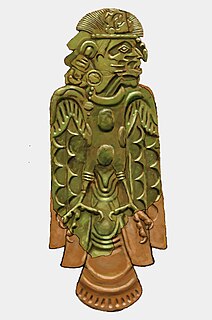
Hunan cuisine, also known as Xiang cuisine, consists of the cuisines of the Xiang River region, Dongting Lake and western Hunan Province in China. It is one of the Eight Great Traditions of Chinese cuisine and is well known for its hot and spicy flavours, fresh aroma and deep colours. Common cooking techniques include stewing, frying, pot-roasting, braising and smoking. Due to the high agricultural output of the region, ingredients for Hunan dishes are many and varied.

Metamorphic rocks arise from the transformation of existing rock to new types of rock, in a process called metamorphism. The original rock (protolith) is subjected to temperatures greater than 150 to 200 °C and, often, elevated pressure, causing profound physical or chemical changes. During this process, the rock remains mostly in the solid state, but gradually recrystallizes to a new texture or mineral composition. The protolith may be a sedimentary, igneous, or existing metamorphic rock.

Hunan is a landlocked province of the People's Republic of China, part of the South Central China region. Located in the middle reaches of the Yangtze watershed, it borders the province-level divisions of Hubei to the north, Jiangxi to the east, Guangdong and Guangxi to the south, Guizhou to the west and Chongqing to the northwest. Its capital and largest city is Changsha, which also abuts the Xiang River. With a population of just over 67 million as of 2014 residing in an area of approximately 210,000 km2 (81,000 sq mi), it is China's 7th most populous province by population and the 10th most extensive province by area. Its 2018 nominal GDP was more than US$500 billion, which is among the top 30 largest sub-national economies in the world with its PPP GDP being over US$1 trillion.

Placodermi is a class of armoured prehistoric fish, known from fossils, which lived from the Silurian to the end of the Devonian period. Their head and thorax were covered by articulated armoured plates and the rest of the body was scaled or naked, depending on the species. Placoderms were among the first jawed fish; their jaws likely evolved from the first of their gill arches. Placoderms are thought to be paraphyletic, consisting of several distinct outgroups or sister taxa to all living jawed vertebrates, which originated among their ranks. This is illustrated by a 419-million-year-old fossil, Entelognathus, from China, which is the only known placoderm with a type of bony jaw like that found in modern bony fishes. This includes a dentary bone, which is found in humans and other tetrapods. The jaws in other placoderms were simplified and consisted of a single bone. Placoderms were also the first fish to develop pelvic fins, the precursor to hindlimbs in tetrapods, as well as true teeth. Paraphyletic groupings are problematic, as one can not talk precisely about their phylogenic relationships, characteristic traits, and complete extinction. 380-million-year-old fossils of three other genera, Incisoscutum, Materpiscis and Austroptyctodus, represent the oldest known examples of live birth. In contrast, one 2016 analysis concluded that placodermi are likely monophyletic.
Maojia is a mixed language in Southern China. Maojiahua is an unclassified Sinitic language that has undergone influence from Hmongic languages.
Agustinia is a genus of sauropod dinosaurs from the Early Cretaceous Period of South America. It contains the single species Agustinia ligabuei, a single specimen which was recovered from the Lohan Cura Formation of Neuquen Province in Argentina. It lived about 116-108 million years ago, in the Aptian-Albian stage of the Early Cretaceous Period.

Eusthenodon is an extinct genus of prehistoric tristichopterids from the Late Devonian period, ranging between 383 and 359 million years ago. They are well known for being a cosmopolitan genus with remains being recovered from East Greenland, Australia, Central Russia, South Africa, and Belgium. Compared to the other closely related genera of the Tristichopteridae clade, Eusthenodon was one of the largest lobe-finned fishes and among the most derived tristichopterids alongside its close relatives Cabonnichthys and Mandageria.

Pharyngeal teeth are teeth in the pharyngeal arch of the throat of cyprinids, suckers, and a number of other fish species otherwise lacking teeth.

Fuchsia Dunlop is an English writer and cook who specialises in Chinese cuisine, especially that of Sichuan, and was the first westerner to train as a chef at the Sichuan Institute of Higher Cuisine in Chengdu. She is the author of five books, including the autobiographical Shark's Fin and Sichuan Pepper (2008). According to Julia Moskin in the New York Times, Dunlop "has done more to explain real Chinese cooking to non-Chinese cooks than anyone".

The palaeoscolecids are a group of extinct ecdysozoan worms resembling armoured priapulids. They are known from the Lower Cambrian to the late Silurian; they are mainly found as disarticulated sclerites, but are also preserved in many of the Cambrian lagerstätten. They take their name from the typifying genus Palaeoscolex.
Hunan Valin Steel Co., Ltd. is a Chinese state-owned company based in Changsha. Founded in 1997, it is based in Hunan, and is primarily engaged in the smelting, manufacture and sale of iron and steel products, as well as nonferrous metal products. As of 8 November 2016, the company was a constituent of SZSE 1000 Index but not in SZSE Component Index. With a market capitalization of $2.3 billion in May 2015, the company was ranked #1,858 on Forbes Global 2000 list.

Century eggs, also known as preserved eggs, hundred-year eggs, thousand-year eggs, thousand-year-old eggs, millennium eggs, skin eggs, or black eggs, are a Chinese egg-based culinary dish made by preserving duck, chicken or quail eggs in a mixture of clay, ash, salt, quicklime, and rice hulls for several weeks to several months, depending on the method of processing.

The Wulfing cache, or Malden plates, are eight Mississippian copper plates crafted by peoples of the Mississippian culture. They were discovered in Dunklin County, Missouri in 1906 by Ray Grooms, a farmer, while plowing a field south of Malden. The repousséd copper plates were instrumental to archaeologists' developing the concept known as the Southeastern Ceremonial Complex.
The Hunan softshell turtle is a species of turtle in the family Trionychidae, the softshells. It is endemic to China, where it occurs in Hunan Province. It is found in Taoyuan, Pingjiang, Rucheng, Lingling, and Shaoyang counties of Hunan province.

Silurolepis platydorsalis is an extinct species of Silurian-aged "maxillate" placoderm that has been described from (mostly) articulated remains. Although it has been known for several years, it was finally described by Zhang, et al., in 2010. The earliest described placoderm is the yunnanolepid antiarch, Shimenolepis, from Llandovery Hunan. In contrast to S. platydorsalis, Shimenolepis is known only from distinctively ornamented thoracic armor plates that bear anatomic features unique to yunnanolepids.

Yunnanolepididae is an extinct family of primitive Antiarch placoderms characterized by having short, broad skull roofs, and by having a feature on the visceral side of the posterior medial dorsal plate, the crista transversalis interna posterior, which is diagnostic of antiarchs, turning forward, and lying in front of the posterior ventral process and pit.

Chinese regional cuisines are the different cuisines found in different provinces and prefectures of China as well as from larger Chinese communities overseas.
Phymosteus liui is a large selenosteid arthrodire placoderms known from the Lower Famennian Xiejingshi Formation of Shimen County, Hunan province, in central China.
Hunan embroidery, or Xiang embroidery, as one of the traditional folk arts of China, together with Suzhou embroidery, Sichuan embroidery, and Cantonese embroidery, is regarded as the four most distinguished embroidery styles in China. It is a general name for the embroidery products which rise from and are mostly produced at Changsha, Hunan, with distinct characteristics of Chu culture. Hunan embroidery is particularly famous in embroidering with silk thread, and the patterns have a high sense of reality. In 2006, Hunan embroidery was selected into the first batch of national intangible cultural heritage list.

Shimenolepis granifera is an extinct yunnanolepid placoderm from the Late Llandovery of Li County, Hunan, China. It was the first described Silurian placoderm, and is the earliest known placoderm, known from distinctively ordered plates.















